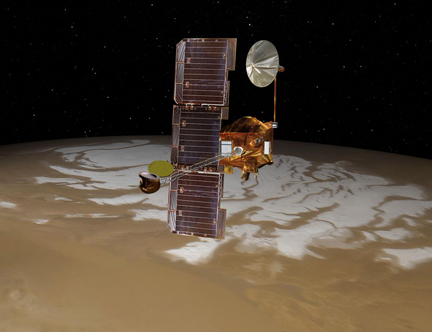Orbiter nudged back into position to cover upcoming Mars landing
By WILLIAM HARWOOD
CBS News
A six-second rocket firing Tuesday nudged NASA's ailing Mars Odyssey orbiter back into position to relay telemetry from the Mars Science Laboratory back to Earth in near realtime during the $2.5 billion rover's rocket-powered descent to the red planet's surface on Aug. 6, officials said.
Odyssey entered "safe mode" July 11 after problems with the craft's attitude control system, raising the possibility that the orbiter might not be properly positioned to relay entry, descent and landing data from the rover back to Earth. While the Curiosity rover will be sending X-band signal tones directly back to Earth marking off major entry events, the landing site -- Gale Crater -- will drop below the horizon well before touchdown, cutting off line-of-sight communications.
NASA's Mars Reconnaissance Orbiter will be overhead throughout the descent, but it can only store telemetry from the lander and send it back to Earth later, after processing. Another orbiter, the European Space Agency's Mars Express satellite, also will monitor the rover's descent, but it will fly beyond the landing zone before touchdown and in any case, it must store data before later transmission to Earth.
Only Odyssey, which arrived at Mars in 2001, is capable of relaying UHF telemetry from the Mars Science Laboratory directly back to Earth during the descent to the surface. But because of the malfunction July 11, Odyssey's trajectory changed very slightly and without a rocket firing, it would have passed over the landing site after the rover's touchdown.
In that case, flight controllers at NASA's Jet Propulsion Laboratory in Pasadena, Calif., would have faced the prospect of an uncomfortable delay before finding out whether or not the rover made it down intact.
But after assessing Odyssey's health, its trajectory and a variety of other factors, flight controllers ordered a six-second thruster burn Tuesday that moved the satellite about six minutes ahead in its orbit, according to a NASA statement. That should allow Odyssey to "see" the final moments of the Mars Science Laboratory's descent and to relay confirmation of landing back to Earth in near realtime.
Touchdown is expected around 1:31 a.m. EDT (GMT-4) on Aug. 6.
"Information we are receiving indicates the maneuver has completed as planned," Gaylon McSmith, the Mars Odyssey project manager, said in a NASA statement. "Odyssey has been working at Mars longer than any other spacecraft, so it is appropriate that it has a special role in supporting the newest arrival."
CBS News
 |
| In this computer graphic, NASA's Mars Odyssey satellite is seen passing over Mars. Odyssey's orbit was adjusted Tuesday to make sure it will be in position to relay data from the Mars Science Laboratory rover during its descent to the surface Aug. 6. (Credit: NASA) |
Odyssey entered "safe mode" July 11 after problems with the craft's attitude control system, raising the possibility that the orbiter might not be properly positioned to relay entry, descent and landing data from the rover back to Earth. While the Curiosity rover will be sending X-band signal tones directly back to Earth marking off major entry events, the landing site -- Gale Crater -- will drop below the horizon well before touchdown, cutting off line-of-sight communications.
 |
| An artist's impression of the Mars Science Laboratory rover on the surface of the red planet. (Credit: NASA) |
Only Odyssey, which arrived at Mars in 2001, is capable of relaying UHF telemetry from the Mars Science Laboratory directly back to Earth during the descent to the surface. But because of the malfunction July 11, Odyssey's trajectory changed very slightly and without a rocket firing, it would have passed over the landing site after the rover's touchdown.
In that case, flight controllers at NASA's Jet Propulsion Laboratory in Pasadena, Calif., would have faced the prospect of an uncomfortable delay before finding out whether or not the rover made it down intact.
But after assessing Odyssey's health, its trajectory and a variety of other factors, flight controllers ordered a six-second thruster burn Tuesday that moved the satellite about six minutes ahead in its orbit, according to a NASA statement. That should allow Odyssey to "see" the final moments of the Mars Science Laboratory's descent and to relay confirmation of landing back to Earth in near realtime.
Touchdown is expected around 1:31 a.m. EDT (GMT-4) on Aug. 6.
"Information we are receiving indicates the maneuver has completed as planned," Gaylon McSmith, the Mars Odyssey project manager, said in a NASA statement. "Odyssey has been working at Mars longer than any other spacecraft, so it is appropriate that it has a special role in supporting the newest arrival."